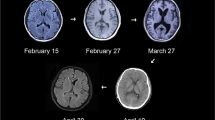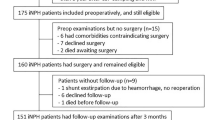Abstract
Objectives
To evaluate clinical response after external lumbar drainage (ELD) and ventriculoperitoneal shunting (VPS) in a cohort of patients with idiopathic normal pressure hydrocephalus associated with parkinsonism (iNPH-P), considering parkinsonism as clinical primary outcome.
Methods
Patients underwent long-term 72-h intracranial pressure-controlled CSF ELD. Clinical motor response before and after ELD was evaluated using changes in UPDRS-ME as outcome measure. A standardized cognitive assessment was also performed. iNPH-P patients who underwent VPS were clinically followed-up after surgery.
Results
Fourteen iNPH-P patients (age: 69.3 ± 11.6 years) were studied. The time of evaluation after ELD removal was 3.5 ± 1.8 days. We observed a significant motor improvement after the drainage in eight (57.1%) patients. Percent clinical motor response was 18.4 ± 6.7%. Twelve (85.7%) patients underwent VPS. Nine patients were examined after surgery at 31.6 ± 7 months. Four (44.4%) patients presented a clinically detectable improvement in motor response after VPS. No significant changes in cognitive performances were detected.
Conclusions
A clinically detectable motor response on parkinsonian signs was observed in a consistent part of iNPH-P patients few days after ELD as well as over two and half years after VPS. Parkinsonism should be considered as outcome measure for the clinical management of patients with iNPH-P.
Similar content being viewed by others
Data availability statement
Data that support the findings of this study are available from the corresponding author upon reasonable request.
References
Hakim S, Adams AR (1965) The special clinical problem of symptomatic hydrocephalus with normal cerebrospinal fluid pressure. Observations on cerebrospinal fluid hydrodynamics. J Neurol Sci 2:307–327
Jaraj D, Rabiei K, Marlow T, Jensen C, Skoog I, Wikkelsø C (2014) Prevalence of idiopathic normal-pressure hydrocephalus. Neurology 82:1449–1454
Currà A, Pierelli F, Gasbarrone R et al (2019) The ventricular system enlarges abnormally in the seventies, earlier in men, and first in the frontal horn: a study based on more than 3,000 scans. Front Aging Neurosci 11:294
Missori P, Currà A (2015) Progressive cognitive impairment evolving to dementia parallels parieto-occipital and temporal enlargement in idiopathic chronic hydrocephalus: a retrospective cohort study. Front Neurol 6:15
Halperin JJ, Kurlan R, Schwalb JM, Cusimano MD, Gronseth G, Gloss D (2015) Practice guideline: Idiopathic normal pressure hydrocephalus: Response to shunting and predictors of response: Report of the Guideline Development, Dissemination, and Implementation Subcommittee of the American Academy of Neurology. Neurology 85:2063–2071
Grasso G, Torregrossa F, Leone L, Frisella A, Landi A (2019) Long-Term efficacy of shunt therapy in idiopathic normal pressure hydrocephalus. World Neurosurg 129:e458-463
Giannini G, Palandri G, Ferrari A et al (2019) A prospective evaluation of clinical and instrumental features before and after ventriculo-peritoneal shunt in patients with idiopathic Normal pressure hydrocephalus: the bologna PRO-hydro study. Parkinsonism Relat Disord 66:117–124
Mihalj M, Dolić K, Kolić K, Ledenko V (2016) CSF tap test—obsolete or appropriate test for predicting shunt responsiveness? A systemic review. J Neurol Sci 362:78–84
Malm J, Kristensen B, Karlsson T, Fagerlund M, Elfverson J, Ekstedt J (1995) The predictive value of cerebrospinal fluid dynamic tests in patients with the idiopathic adult hydrocephalus syndrome. Arch Neurol 52:783–789
Marmarou A, Bergsneider M, Klinge P, Relkin N, Black PM (2005) The value of supplemental prognostic tests for the preoperative assessment of idiopathic normal-pressure hydrocephalus. Neurosurgery 57(3 Suppl):S17–S28
Wikkelsø C, Hellström P, Klinge PM, Tans JTJ, European iNPH Multicentre Study Group (2013) The European iNPH Multicentre Study on the predictive values of resistance to CSF outflow and the CSF Tap Test in patients with idiopathic normal pressure hydrocephalus. J Neurol Neurosurg Psychiatry 84:562–568
Walchenbach R, Geiger E, Thomeer RT, Vanneste JA (2002) The value of temporary external lumbar CSF drainage in predicting the outcome of shunting on normal pressure hydrocephalus. J Neurol Neurosurg Psychiatry 72:503–506
Schniepp R, Trabold R, Romagna A et al (2017) Walking assessment after lumbar puncture in normal-pressure hydrocephalus: a delayed improvement over 3 days. J Neurosurg 126:148–157
Molde K, Söderström L, Laurell K (2017) Parkinsonian symptoms in normal pressure hydrocephalus: a population-based study. J Neurol 264:2141–2148
Broggi M, Redaelli V, Tringali G et al (2016) Normal pressure hydrocephalus and parkinsonism: preliminary data on neurosurgical and neurological treatment. World Neurosurg 90:348–536
Kang K, Jeon JS, Kim T et al (2016) Asymmetric and upper body Parkinsonism in patients with idiopathic normal-pressure hydrocephalus. J Clin Neurol Seoul Korea 12:452–459
Akiguchi I, Ishii M, Watanabe Y et al (2008) Shunt-responsive parkinsonism and reversible white matter lesions in patients with idiopathic NPH. J Neurol 255:1392–1399
Relkin N, Marmarou A, Klinge P, Bergsneider M, Black PM (2005) Diagnosing idiopathic normal-pressure hydrocephalus. Neurosurgery 57(3 Suppl):S4–S16
Evans WA (1942) An encephalographic ratio for estimating ventricular enlargment and cerebral atrophy. Arch Neurol Psychiatry 47:931–937
Postuma RB, Berg D, Stern M et al (2015) MDS clinical diagnostic criteria for Parkinson’s disease. Mov Disord 30:1591–1601
Kubo Y, Kazui H, Yoshida T et al (2008) Validation of grading scale for evaluating symptoms of idiopathic normal-pressure hydrocephalus. Dement Geriatr Cogn Disord 25:37–45
Folstein MF, Folstein SE, McHugh PR (1975) ‘Mini-mental state’. A practical method for grading the cognitive state of patients for the clinician. J Psychiatr Res 12:189–198
Dubois B, Slachevsky A, Litvan I, Pillon B (2000) The FAB: a frontal assessment battery at bedside. Neurology 55:1621–1626
Uttl B, Graf P (1997) Color-word stroop test performance across the adult life span. J Clin Exp Neuropsychol 19:405–420
Marra C, Gainotti G, Scaricamazza E, Piccininni C, Ferraccioli M, Quaranta D (2013) The multiple features target cancellation (MFTC): an attentional visual conjunction search test. Normative values for the Italian population. Neurol Sci 34:173–180
Carlesimo GA, Caltagirone C, Gainotti G (1996) The Mental Deterioration Battery: normative data, diagnostic reliability and qualitative analyses of cognitive impairment. The Group for the Standardization of the Mental Deterioration Battery. Eur Neurol 36:378–384
Novelli G, Papagno C, Capitani E, Laiacona M (1986) Tre test clinici di ricerca e produzione lessicale. Taratura su sogetti normali. [Three clinical tests to research and rate the lexical performance of normal subjects.]. Arch Psicol Neurol Psichiatr 47:477–506
Yamada S, Ishikawa M, Miyajima M, SINPHONI-2 Investigators (Appendix) et al (2017) Disease duration: the key to accurate CSF tap test in iNPH. Acta Neurol Scand 135:189–196
El Ahmadieh TY, Wu EM, Kafka B et al (2019) Lumbar drain trial outcomes of normal pressure hydrocephalus: a single-center experience of 254 patients. J Neurosurg 132:306–312
Ko PW, Lee HW, Kang K (2017) Frontal assessment battery and cerebrospinal fluid tap test in idiopathic normal-pressure hydrocephalus. Eur Neurol 77:327–332
Pujari S, Kharkar S, Metellus P, Shuck J, Williams MA, Rigamonti D (2008) Normal pressure hydrocephalus: long-term outcome after shunt surgery. J Neurol NeurosurgPsychiatry 79:1282–1286
Curran T, Lang AE (1994) Parkinsonian syndromes associated with hydrocephalus: case reports, a review of the literature, and pathophysiological hypotheses. Mov Disord 9:508–520
Lenfeldt N, Larsson A, Nyberg L et al (2008) Idiopathic normal pressure hydrocephalus: increased supplementary motor activity accounts for improvement after CSF drainage. Brain 131:2904–2912
Haslinger B, Erhard P, Kämpfe N et al (2001) Event-related functional magnetic resonance imaging in Parkinson’s disease before and after levodopa. Brain 124:558–570
Ouchi Y, Nakayama T, Kanno T, Yoshikawa E, Shinke T, Torizuka T (2007) In vivo presynaptic and postsynaptic striatal dopamine functions in idiopathic normal pressure hydrocephalus. J Cereb Blood Flow Metab 27:803–810
Nakayama T, Ouchi Y, Yoshikawa E, Sugihara G, Torizuka T, Tanaka K (2007) Striatal D2 receptor availability after shunting in idiopathic normal pressure hydrocephalus. J Nucl Med 48:1981–1986
Haan J, Thomeer RT (1998) Predictive value of temporary external lumbar drainage in normal pressure hydrocephalus. Neurosurgery 22:388–391
Marmarou A, Young HF, Aygok GA et al (2005) Diagnosis and management of idiopathic normal-pressure hydrocephalus: a prospective study in 151 patients. J Neurosurg 102:987–997
Panagiotopoulos V, Konstantinou D, Kalogeropoulos A, Maraziotis T (2005) The predictive value of external continuous lumbar drainage, with cerebrospinal fluid outflow controlled by medium pressure valve, in normal pressure hydrocephalus. Acta Neurochir (Wien) 147:953–958
Espay AJ, Narayan RK, Duker AP, Barrett ET, de Courten-Myers G (2008) Lower-body parkinsonism: reconsidering the threshold for external lumbar drainage. Nat Clin Pract Neurol 4:50–55
Governale LS, Fein N, Logsdon J, Black PM (2008) Techniques and complications of external lumbar drainage for normal pressure hydrocephalus. Neurosurg 63(4 Suppl 2):379–384
Lenfeldt N, Hauksson J, Birgander R, Eklund A, Malm J (2008) Improvement after cerebrospinal fluid drainage is related to levels of N-acetyl-aspartate in idiopathic normal pressure hydrocephalus. Neurosurgery 62:135–141
Tarnaris A, Toma AK, Chapman MD et al (2009) The longitudinal profile of CSF markers during external lumbar drainage. J Neurol Neurosurg Psychiatry 80:1130–1133
Leinonen V, Menon LG, Carroll RS et al (2011) Cerebrospinal fluid biomarkers in idiopathic normal pressure hydrocephalus. Int J Alzheimers Dis 2011:312526
Lenfeldt N, Hansson W, Larsson A, Birgander R, Eklund A, Malm J (2012) Three-day CSF drainage barely reduces ventricular size in normal pressure hydrocephalus. Neurology 79:237–242
Singer OC, Melber J, Hattingen E et al (2012) MR volumetric changes after diagnostic CSF removal in normal pressure hydrocephalus. J Neurol 259:2440–2446
Ivkovic M, Reiss-Zimmermann M et al (2015) MRI assessment of the effects of acetazolamide and external lumbar drainage in idiopathic normal pressure hydrocephalus. Fluids Barr CNS 12:9
Mahr CV, Dengl M, Nestler U et al (2016) Idiopathic normal pressure hydrocephalus: diagnostic and predictive value of clinical testing, lumbar drainage, and CSF dynamics. J Neurosurg 125:591–597
Yang F, Hickman TT, Tinl M et al (2016) Quantitative evaluation of changes in gait after extended cerebrospinal fluid drainage for normal pressure hydrocephalus. J Clin Neurosci 28:31–37
Gallina P, Lastrucci G, Caini S, Di Lorenzo N, Porfirio B, Scollato A (2018) Accuracy and safety of 1-day external lumbar drainage of CSF for shunt selection in patients with idiopathic normal pressure hydrocephalus. J Neurosurg 1:1–7
Funding
None.
Author information
Authors and Affiliations
Corresponding author
Ethics declarations
Conflicts of interest
The authors declare that they have no conflict of interest.
Ethics approval
this retrospective study was approved by the Local Ethics Committee. It strictly included standardized clinical information recorded during patients’ diagnostic work-up and follow-up visits.
Informed consent
Written informed consent was obtained.
Rights and permissions
About this article
Cite this article
Mostile, G., Portaro, G., Certo, F. et al. iNPH with parkinsonism: response to lumbar CSF drainage and ventriculoperitoneal shunting. J Neurol 268, 1254–1265 (2021). https://doi.org/10.1007/s00415-020-10267-x
Received:
Revised:
Accepted:
Published:
Issue Date:
DOI: https://doi.org/10.1007/s00415-020-10267-x




